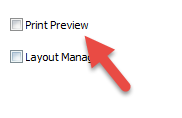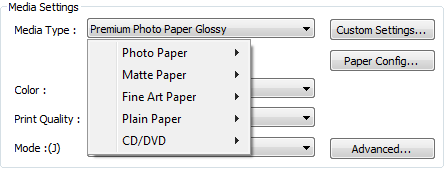
The printer driver's main tab is similar to other Epson printers from the last few years. From this tab, you control the media type, color mode, print quality, paper source, paper size, and advanced paper handling options.

The driver also includes a Print Preview option. This is separate and not connected to the preview already displayed by Photoshop, Elements, and Lightroom. We recommend you do not use the driver preview. It will often interrupt the color management process if you use ICC printer / paper profiles.
Photo Black Ink vs. Matte Black Ink

The media type also dictates the use of Photo or Matte black. For example, glossy and luster will use Photo Black while matte and most fine art settings use Matte Black. You can also execute the change using the printer's control panel. The switch can be automatic based on media selection, or you can choose to receive a warning when change is required. This feature is found on the printer's control panel under System Administration > Printer Settings > BK Ink Auto Change. We recommend you turn it off to prevent unwanted switching.
Media Type

You must designate the type of inkjet paper (media) you use with each print. You can think of media type as part color profile and part ink throttle. Different inkjet papers need different amounts of ink to perform properly; this is where the media setting becomes important.
Choosing the right media type is important, even if you use ICC color profiles. The right choice should be included with your profile's instructions. It is important to note that the drop-down menu above is a fixed list and only contains Epson media names. When using non-Epson papers, you will choose the closest media type.
Quality Options

To get to this menu, go to the Print Quality drop-down and choose Quality Options. We recommend using this menu so you can verify the print quality setting.
Quality Options
- 2880 x 1440 dpi (Level 5)
- 1440 x 720 dpi (Level 4) - Lowest choice available for glossy, luster, fine art settings
- 720 x 720 dpi (Level 3) - Available for photo matte and plain paper media settings
- 720 x 360 dpi (Level 2) - Available for plain paper media setting
The High-Speed option puts down ink each time the print head passes over the paper. Turning High Speed off means the print head only puts down ink in one direction. For most, high speed yields excellent results. For even better quality, turn high speed off if you see fine banding that runs parallel to the print head path.
The Edge Smoothing option optimizes the appearance of low-resolution images by smoothing jagged edges and lines. For best image quality, you should turn this feature off and instead make your files 300ppi resolution.
Finest Detail (an option in the Windows driver) improves quality noticeably. We recommend turning it on for most print jobs. The setting appears to be the default in the Mac driver and cannot be turned off.
Mode

This drop-down controls printer color management. The first three (EpsonStandard, Adobe RGB, and PhotoEnhance) are Epson color management options. ICM is rarely used and runs color management through the Windows OS.
When using a printer color profile for your paper, select Off (No Color Adjustment). This shuts down the P800's color management engine and puts your photo software in control of the process.
Paper Configuration

Platen Gap
This menu is most important when using thick papers. Any paper over the standard 10.4 mil photo thickness warrants the platen gap being set to Wide.
Paper Thickness
The paper thickness control is useful when you use media above 15mil thick. Canvas is an excellent example where thickness can easily exceed 19mil. The control is measured in tenths of a millimeter. Over the years, we have determined that setting paper thickness to 6 works well and provides good quality with enough clearance to avoid head strikes.
Color Density
The Color Density control acts to fine-tune ink usage. If you encounter a paper that warps or buckles under heavy ink loads (this is usually image-dependent), try setting Color Density to minus 10. It will normally help with control warping and will not degrade image quality.
The Drying Time per Print Head Pass is not often needed. We recommend increasing dry times for metals, translucent media, and materials you've coated by hand.
Paper Sizes

The P800 driver comes with a variety of preset paper sizes as well as controls to define custom sizes.

A number of these sizes can be printed without borders:
- 3.5 x 5
- 4 x 6
- 5 x 7
- 5 x 8
- 4 x 7.11
- 8 x 10
- A3
- A4
- 8.5 x 11
- 11 x 17
- 10 x 12
- 11 x 14
- 13 x 19
- 16 x 20
- A2
- 17 x 22
User Defined Paper Sizes

Like other Epson printers, the Epson SureColor P800 allows you to define custom paper sizes. The limits:
Paper Width: 3.5" - 17"
Paper Height (Length): 3.5" - 590.55"
The maximum print length is likely determined by file size. With high-resolution images, you'll likely reach the size limit at 60-70" print length.
Custom Borderless Now An Option

You can define limited custom sizes to print without borders. Borderless width choices are preset at the factory and are chosen from a drop-down menu (see above). Paper height (length) is user-defined from 5" to 590.55"
This feature opens fun opportunities for printing borderless greeting cards and pano and landscape prints.
Borderless Greeting Cards
You can now print Red River Paper's 7x10, 8.5x5.5, and 8x9 Pano Cards without borders. Get Instructions for Setting Up these Custom Borderless Sizes.
Pano and Landscape Prints
You can now print stunning panos and landscape images on Red River Paper's 13" x 38" and 8.5" x 25" Flat Sheets.
Page Layout

The page layout tab is like most other Epson printers. Print orientation, number of copies, layout options, and a host of other features we'll probably never use!
Job Settings

One interesting option is the Job Settings feature. By checking the Job Settings box and then clicking the Details button, you will be presented with the menu below.

Your print will then contain all of the information you've selected. As you can see below, the detailed information fits nicely at the top.

For those who like to record settings for future use or just like to know what settings work, the Job Settings feature should be a welcome addition.
Utility Tab

You should visit this tab often to perform routine printer checks and maintenance. The Nozzle Check, Head Cleaning, and Print Head Alignment are all critical tools to have it you experience a drop in print quality.
You can quickly bring up the print queue if you need to check on a job. Epson allows you to move printer driver controls around using the Menu Arrangement feature.
A nice addition is the Driver Update button, which quickly checks with Epson to see if you have the latest software. An internet connection is required for this feature.
Advanced Black & White
The Epson P800 has three black inks available for your printing needs. Using the Advanced Black & White (ABW) mode, the P800 blends these inks to create a totally neutral black & white image. The system can also create toned grayscale images from cool to warm to sepia.
Access to the ABW mode starts in the main menu under the color option. See below.

When ABW is chosen, the Mode drop-down changes, as seen below. This is the quick method of using ABW for quick neutral or tone images.

ABW Details

For more detailed adjustments, clicking the Advanced button above brings up the Color Controls menu for ABW.
Several variables are available, including a color wheel for precise toning work. The only issue you'll find with these controls is the lack of a "live" preview of your image in the driver dialog. You are provided with a static image showing the effects of different settings.
- Color Toning - Available settings are Neutral, Cool, Warm, and Sepia.
- Tone - Changes the entire tonal scale of an image. Epson recommends that the Dark setting may be best.
- Shadow & Highlight Tonality - Control the grayscale tone, specifically at the top and bottom of the scale.
- Max Optical Density - Adjusts the focus of the overall print. Set the density lower for a softer print.
- Highlight Point Shift - Helps to reduce gloss differential by adding some density to highlights. This setting would be for glossy and satin/luster papers.
- Tone Color Circle - Pick a specific color tone for your image.
Ready to Learn More? Read the Epson SureColor P800 cost of printing report.
Last updated: February 10, 2025




